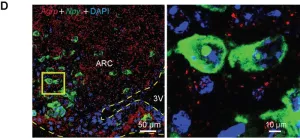(Press-News.org) A pair of internationally renowned stem cell cloning experts at the University of Houston is reporting their findings of variant cells in the lungs of patients with Idiopathic Pulmonary Fibrosis (IPF) which likely represent key targets in any future therapy for the condition.
IPF is a progressive, irreversible and fatal lung disease in which the lungs become scarred and breathing becomes difficult. The rapid development and fatal progression of the disease occur by uncertain mechanisms, but the most pervasive school of thought is that IPF arises from recurrent, subclinical lung injury that imparts changes to epithelial and stromal cells, which, in turn, compromise lung repair and favor fibrosis.
To dig deeper into the cause of IPF, Frank McKeon, professor of biology and biochemistry and director of the Stem Cell Center, and Wa Xian, research associate professor at the center, used single cell cloning technologies to generate libraries of basal stem cells from the lungs of 16 patients with IPF and 10 patients without the disease.
Houston Methodist Lung Transplant Center provided the lung tissue from patients who underwent transplant for end-stage lung disease from which some of these basal cell clones were generated. The basal cells were used because consistently single-cell RNA sequencing studies have identified lung basal cells in IPF.
“We identified a major stem cell variant that was distinguished from normal stem cells by its ability to transform normal lung fibroblasts to pathogenic myofibroblasts in vitro and to activate and recruit myofibroblasts in clonal xenografts,” reports Xian and McKeon in Science Translational Medicine.
"This study breaks new ground by showing lung fibrosis is driven by specific basal stem cell variants that become overly abundant in diseased lungs,” said Howard J. Huang, M.D., Medical Director, Houston Methodist Lung Transplant Center. “Importantly, these variants are distinct from abnormal variants identified in other chronic lung diseases. These findings suggest therapies selectively targeting these pathogenic stem cell variants may ameliorate fibrotic lung disease progression."
The concept that IPF is associated with aberrant epithelial cell types is consistent with a recent clonogenic analysis of chronic obstructive pulmonary disease (COPD) conducted by Xian and McKeon. It linked the widespread lung disease to the emergence of three discrete and clonogenic epithelial distal airway stem cell variants that autonomously promote mucin hypersecretion, fibrosis and inflammation.
“In this study, we applied the same single cell cloning technology used to assess COPD to the lungs of patients with IPF. In contrast to the three pathogenic basal cell variants found to dominate the COPD lung, lungs with advanced IPF showed a major basal cell variant in addition to the normal distal airway stem cell,” said Xian. “This IPF variant showed constitutive expression of proinflammatory and profibrotic genes and displayed the functional capacity to orchestrate the fibrotic state both in vitro and in vivo.”
Understanding how these minor variants are differentially amplified in COPD, IPF and perhaps other lung conditions will refine the specific risk factors for these diseases.
“Conversely, deciphering why these variants come to dominate the lung could aid in our ability to treat these conditions,” said McKeon.
END
Odd cells found in lungs of patients with idiopathic pulmonary fibrosis
Finding could be future target for drug therapy
2023-05-17
ELSE PRESS RELEASES FROM THIS DATE:
What did the earliest animals look like?
2023-05-17
For more than a century, biologists have wondered what the earliest animals were like when they first arose in the ancient oceans over half a billion years ago.
Searching among today's most primitive-looking animals for the earliest branch of the animal tree of life, scientists gradually narrowed the possibilities down to two groups: sponges, which spend their entire adult lives in one spot, filtering food from seawater; and comb jellies, voracious predators that oar their way through the world's oceans in search of food.
In a new study published this week in the journal Nature, researchers use a novel approach based on chromosome structure to come up with ...
Researchers pinpoint brain cells that drive appetite in obesity
2023-05-17
A team at the Garvan Institute of Medical Research has discovered a group of brain cells that boosts appetite when there is a prolonged surplus of energy in the body, such as excess fat accumulation in obesity.
The researchers discovered that these cells not only produced the appetite-stimulating molecule NPY, but they in fact made the brain more sensitive to the molecule, boosting appetite even more.
“These cells kickstart changes in the brain that make it more sensitive to even low levels of NPY when there is a surplus of energy in the body in the form of excess fat – driving appetite during obesity,” explains Professor Herbert Herzog, senior ...
Receipt of medications for chronic disease during the first 2 years of COVID-19
2023-05-17
About The Study: This study of 18.1 million beneficiaries of fee-for service Medicare found that, in contrast to in-person health services, receipt of medications for chronic conditions was relatively stable in the first 2 years of the COVID-19 pandemic overall, across racial and ethnic groups, and for community-dwelling patients with dementia. This finding of stability may hold lessons for other outpatient services during the next pandemic.
Authors: Nancy E. Morden, M.D., M.P.H., of the Geisel ...
Genetic associations between modifiable risk factors and Alzheimer disease
2023-05-17
About The Study: This genetic association study including 39,000 participants with clinically diagnosed Alzheimer disease (AD) and 401,000 control participants without AD found novel genetic associations between high high-density lipoprotein (HDL) cholesterol concentrations and high systolic blood pressure with higher risk of AD. These findings may inspire new drug targeting and improved prevention implementation.
Authors: Ruth Frikke-Schmidt, M.D., D.M.Sc., Ph.D., of Copenhagen University Hospital–Rigshospitalet in Copenhagen, is the corresponding author.
To access the embargoed study: Visit our For The Media website at this link https://media.jamanetwork.com/
(doi:10.1001/jamanetworkopen.2023.13734)
Editor’s ...
Radio signal reveals supernova origin
2023-05-17
In the latest issue of the journal Nature, astronomers from Stockholm University reveal the origin of a thermonuclear supernova explosion. Strong emission lines of helium and the first detection of such a supernova in radio waves show that the exploding white dwarf star had a helium-rich companion.
Supernovae of Type Ia are important for astronomers since they are used to measure the expansion of the Universe. However, the origin of these explosions has remained an open question. While it is established that the explosion is that of a compact ...
Are Earth and Venus the only volcanic planets? Not anymore.
2023-05-17
Imagine an Earth-sized planet that’s not at all Earth-like. Half this world is locked in permanent daytime, the other half in permanent night, and it’s carpeted with active volcanoes. Astronomers have discovered that planet.
The planet, named LP 791-18d, orbits a small red dwarf star about 90 light years away. Volcanic activity makes the discovery particularly notable for astronomers because volcanism facilitates interaction between a world’s interior and its exterior.
“Why is volcanism important? It is the major source contributing to a planetary atmosphere, and with an atmosphere you could have surface liquid water — a requirement for sustaining ...
A channel involved in pain sensation can also suppress it
2023-05-17
Pain is good. It’s the body’s way to keep an animal from harming itself or repeating a dangerous mistake. But sometimes the debilitating sensation can get in the way. So evolution has devised ways to tamp that response down under certain circumstances.
Researchers at UC Santa Barbara identified the pathway in fruit flies that reduces the sensation of pain from heat. Remarkably, just a single neuron on each side of the animal’s brain controls the response. What’s more, the molecule responsible for suppressing ...
Genetic research offers new perspective on the early evolution of animals
2023-05-17
A study published by MBARI researchers and their collaborators today in Nature provides new insights about one of the earliest points in animal evolution that happened more than 700 million years ago.
For more than a century, scientists have been working to understand the pivotal moment when an ancient organism gave rise to the diverse array of animals in the world today. As technology and science have advanced, scientists have investigated two alternative hypotheses for which animals—sponges or comb jellies, also known as ctenophores—were most distantly related to all other animals. Identifying this outlier—known as the sibling ...
Research spotlight: a conversational artificial intelligence program can generate credible medical information in response to common patient questions
2023-05-17
What was the question you set out to answer with this study?
ChatGPT, a new language processing tool driven by artificial intelligence (AI), provides conversational text responses to questions and can generate valuable information for enquiring individuals, but the quality of ChatGPT-generated answers to medical questions is currently unclear.
What Methods or Approach Did You Use?
We retrieved eight common questions and answers about colonoscopy from the publicly available webpages of three randomly-selected hospitals from the top-20 list of the US News & World Report Best Hospitals for Gastroenterology and Gastrointestinal Surgery.
We ...
How breast cancer arises
2023-05-17
In what may turn out to be a long-missing piece in the puzzle of breast cancer, Harvard Medical School researchers have identified the molecular sparkplug that ignites cases of the disease currently unexplained by the classical model of breast-cancer development.
A report on the team’s work is published May 17 in Nature.
“We have identified what we believe is the original molecular trigger that initiates a cascade culminating in breast tumor development in a subset of breast cancers that are driven by estrogen,” said study senior investigator Peter Park, professor of ...
LAST 30 PRESS RELEASES:
Numbers in our sights affect how we perceive space
SIMJ announces global collaborative book project in commemoration of its 75th anniversary
Air pollution exposure and birth weight
Obstructive sleep apnea risk and mental health conditions among older adults
How talking slows eye movements behind the wheel
The Ceramic Society of Japan’s Oxoate Ceramics Research Association launches new international book project
Heart-brain connection: international study reveals the role of the vagus nerve in keeping the heart young
Researchers identify Rb1 as a predictive biomarker for a new therapeutic strategy in some breast cancers
Survey reveals ethical gaps slowing AI adoption in pediatric surgery
Stimulant ADHD medications work differently than thought
AI overestimates how smart people are, according to HSE economists
HSE researchers create genome-wide map of quadruplexes
Scientists boost cell "powerhouses" to burn more calories
Automatic label checking: The missing step in making reliable medical AI
Low daily alcohol intake linked to 50% heightened mouth cancer risk in India
American Meteorological Society announces Rick Spinrad as 2026 President-Elect
Biomass-based carbon capture spotlighted in newly released global climate webinar recording
Illuminating invisible nano pollutants: advanced bioimaging tracks the full journey of emerging nanoscale contaminants in living systems
How does age affect recovery from spinal cord injury?
Novel AI tool offers prognosis for patients with head and neck cancer
Fathers’ microplastic exposure tied to their children’s metabolic problems
Research validates laboratory model for studying high-grade serous ovarian cancer
SIR 2026 delivers transformative breakthroughs in minimally invasive medicine to improve patient care
Stem Cell Reports most downloaded papers of 2025 highlight the breadth and impact of stem cell research
Oxford-led study estimates NHS spends around 3% of its primary and secondary care budget on the health impacts of heat and cold in England
A researcher’s long quest leads to a smart composite breakthrough
Urban wild bees act as “microbial sensors” of city health.
New study finds where you live affects recovery after a hip fracture
Forecasting the impact of fully automated vehicle adoption on US road traffic injuries
Alcohol-related hospitalizations from 2016 to 2022
[Press-News.org] Odd cells found in lungs of patients with idiopathic pulmonary fibrosisFinding could be future target for drug therapy






